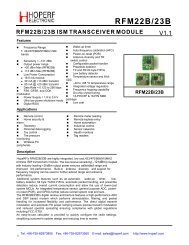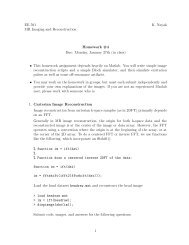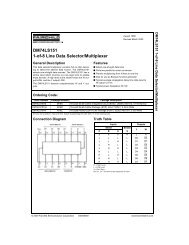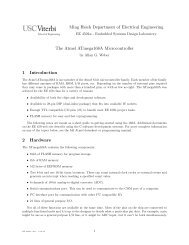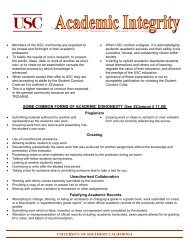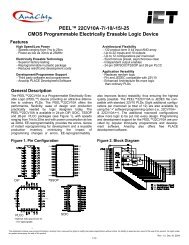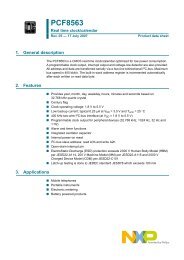Ming Hsieh Department of Electrical Engineering Programming the ...
Ming Hsieh Department of Electrical Engineering Programming the ...
Ming Hsieh Department of Electrical Engineering Programming the ...
You also want an ePaper? Increase the reach of your titles
YUMPU automatically turns print PDFs into web optimized ePapers that Google loves.
Appendix A: Sample program jl16-2b.c<br />
/*************************************************************<br />
* jl16 -2b.c - Demonstrate simple I/O functions <strong>of</strong> MC68HC908JL16<br />
*<br />
* This program will cause a 7- segment display to ei<strong>the</strong>r count up in<br />
* hexadecimal (0 ,1 ,2 ,... ,E,F ,0 ,1 ,...) or count down in decimal<br />
* (9 ,8 ,... ,1 ,0 ,9 ,8 ,..) depending on whe<strong>the</strong>r or not a switch is pressed .<br />
*<br />
* Port A, bit 1 - input from switch (0 = pressed , 1 = not pressed )<br />
* When <strong>the</strong> switch is not pressed , <strong>the</strong> 7- segment display counts<br />
* up in hexadecimal . When <strong>the</strong> switch is pressed , <strong>the</strong> 7- segment<br />
* display counts down in decimal .<br />
* Port B, bits 0 -6 - Outputs to data inputs <strong>of</strong> 74 LS374 register .<br />
* Bit 6 -> segment A, 5->B, ... , 1->F, 0->G<br />
* A low output bit will cause <strong>the</strong> LED segment to light up.<br />
* Port A, bit 5 - Output to positive edge - triggered clock input<br />
* <strong>of</strong> 74 LS374 register .<br />
*<br />
* This examples show how to use <strong>the</strong> zero - page <strong>of</strong> RAM for storing variables<br />
*<br />
*************************************************************/<br />
# include /* for EnableInterrupts macro */<br />
# include " derivative .h" /* include peripheral declarations */<br />
/*<br />
Some <strong>of</strong> <strong>the</strong> RAM on <strong>the</strong> JL16 is in <strong>the</strong> range 0 x60 to 0 xff and can be<br />
accessed using <strong>the</strong> direct addressing mode which is <strong>the</strong> most efficient way<br />
to get at RAM in <strong>the</strong> " zero page " <strong>of</strong> 0 x00 to 0 xff . The rest <strong>of</strong> RAM is from<br />
0 x100 to 0 x25f and must be accessed using extended addressing . For C it<br />
doesn ’t make much difference since <strong>the</strong> compiler will generate <strong>the</strong> correct<br />
instructions . However to make <strong>the</strong> best use <strong>of</strong> assembly code you need to<br />
know where <strong>the</strong> variables have been stored so you know whe<strong>the</strong>r or not direct<br />
addressing can be used . The follwing pragma puts <strong>the</strong> variables in <strong>the</strong> zero<br />
page and <strong>the</strong> wait_100ms routine uses direct addressing .<br />
*/<br />
# pragma DATA_SEG __SHORT_SEG MY_ZEROPAGE<br />
unsigned char digit_segs [16] = {<br />
0x7e ,0 x30 ,0 x6d ,0 x79 ,0 x33 ,0 x5b ,0 x5f ,0 x70 ,<br />
0x7f ,0 x73 ,0 x77 ,0 x1f ,0 x4e ,0 x3d ,0 x4f ,0 x47 };<br />
unsigned char delay0 ;<br />
unsigned char delay1 ;<br />
/*<br />
This pragma sets <strong>the</strong> area for allocating variables back to default area<br />
<strong>of</strong> RAM as defined in <strong>the</strong> PRM file .<br />
*/<br />
# pragma DATA_SEG DEFAULT<br />
void display_digit ( int digit ); // prototype<br />
EE 459Lx, Rev. 5/29/13 16



